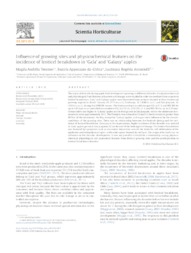Influence of growing sites and physicochemical features on the incidence of lenticel breakdown in 'Gala' and 'Galaxy' apples.
Influence of growing sites and physicochemical features on the incidence of lenticel breakdown in 'Gala' and 'Galaxy' apples.
Autoria: TESSMER, M. A.; GLÓRIA, B. A. da; ANTONIOLLI, L. R.
Resumo: The origin of lenticels during apple fruit development growing in different altitudes, the physicochemical and physiological fruit features at harvest and storage, were studied in order to correlate these aspects to lenticel breakdown. "Gala" and "Galaxy" apples were harvested from orchards located at three traditional growing regions in Brazil: Vacaria, RS (971 m a.s.l.), Fraiburgo, SC (1048 m a.s.l.) and São Joaquim, SC (1353 m a.s.l.), during the 2008/09 season. The fruit were kept in cold storage (CS) at 0 ◦C and 90% RH for up to 120 days or at controlled atmosphere (CA) at 1.5% O2, 2.5% CO2, 0 ◦C and 90% RH for up to 210 days. Colour index was higher in ?Galaxy? apples and in fruit grown in São Joaquim, where the minimum temperatures were approximately 10 ◦C. The firmness was reduced at CS and CA, butit remained greater than 40 N in all the treatments. Acidity, except for ?Galaxy? apples, and sugars were influenced by the climatic conditions of the growing sites. There was no relationship between the lenticels dyeing and the incidence of lenticel breakdown. Contrary to the expectations, higher incidence of the disorder was noticed in ?Gala? apples grown in São Joaquim (SC) at the end of the both types of storage. The lenticel breakdown was featured by symptoms such as concentric depression around the lenticels, cell obliteration of the epidermis and subepidermal layers, with wide spaces formed by cell lysis. The origin of lenticels has no influence on the disorder development. It was not possible to establish a relationship among physicochemical, physiological and anatomical features from distinct growing sites and the predisposition to lenticel breakdown disorder.
Ano de publicação: 2016
Tipo de publicação: Artigo de periódico
Unidade: Embrapa Uva e Vinho
Palavras-chave: Altitude, Lenticels Anatomy, Malus Domestica Borkh, Malus domestica, Storage disorder
Observações
1 - Por padrão são exibidas publicações dos últimos 20 anos. Para encontrar publicações mais antigas, configure o filtro ano de publicação, colocando o ano a partir do qual você deseja encontrar publicações. O filtro está na coluna da esquerda na busca acima.
2 - Para ler algumas publicações da Embrapa (apenas as que estão em formato ePub), é necessário ter, no celular ou computador, um desses softwares gratuitos. Sistemas Android: Google Play Livros; IOS: iBooks; Windows e Linux: software Calibre.
Acesse outras publicações
Acesse a Base de Dados da Pesquisa Agropecuária (BDPA) para consultar o acervo completo das bibliotecas da Embrapa.

